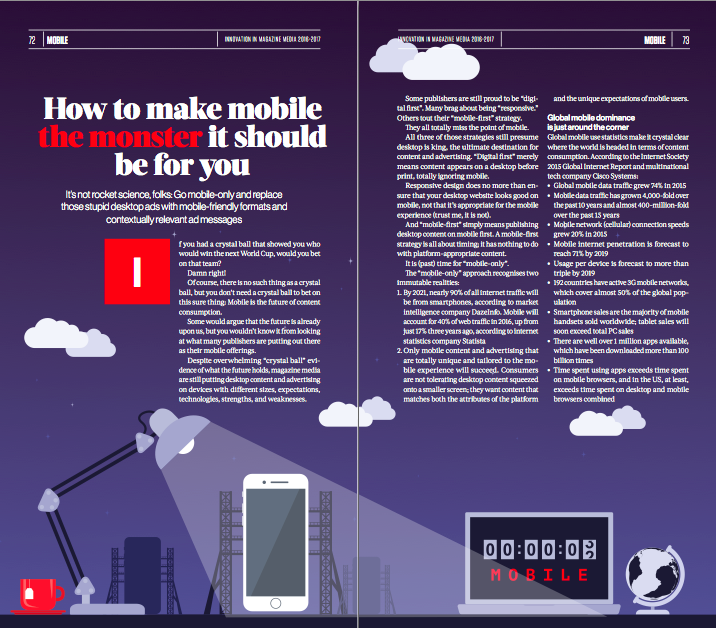
04 Nov How to make mobile the monster it should be for you
It’s not rocket science, folks: Go mobile-only and replace those stupid desktop ads with mobile-friendly formats and contextually relevant ad messages
If you had a crystal ball that showed you who would win the next World Cup, would you bet on that team?
Damn right!
Of course, there is no such thing as a crystal ball, but you don’t need a crystal ball to bet on this sure thing: Mobile is the future of content consumption. Some would argue that the future is already upon us, but you wouldn’t know it from looking at what many publishers are putting out there as their mobile offerings.
Despite overwhelming “crystal ball” evidence of what the future holds, magazine media are still putting desktop content and advertising on devices with different sizes, expectations, technologies, strengths, and weaknesses.
Some publishers are still proud to be “digital first”. Many brag about being “responsive.” Others tout their “mobile-first” strategy. They all totally miss the point of mobile.
All three of those strategies still presume desktop is king, the ultimate destination for content and advertising. “Digital first” merely means content appears on a desktop before print, totally ignoring mobile. Responsive design does no more than ensure that your desktop website looks good on mobile, not that it’s appropriate for the mobile experience (trust me, it is not). And “mobile-first” simply means publishing desktop content on mobile first.
A mobile-first strategy is all about timing; it has nothing to do with platform-appropriate content. It is (past) time for “mobile-only”.
The “mobile-only” approach recognises two immutable realities:
1. By 2021, nearly 90% of all internet traffic will be from smartphones, according to market intelligence company DazeInfo. Mobile will account for 40% of web traffic in 2016, up from just 17% three years ago, according to internet statistics company Statista
2. Only mobile content and advertising that are totally unique and tailored to the mo- bile experience will succeed. Consumers are not tolerating desktop content squeezed onto a smaller screen; they want content that matches both the attributes of the platform and the unique expectations of mobile users.
Global mobile dominance is just around the corner
Global mobile use statistics make it crystal clear where the world is headed in terms of content consumption.
According to the Internet Society 2015 Global Internet Report and multinational tech company Cisco Systems:
- Global mobile data traffic grew 74% in 2015
- Mobile data traffic has grown 4,000-fold over the past 10 years and almost 400-million-fold over the past 15 years
- Mobile network (cellular) connection speeds grew 20% in 2015
- Mobile internet penetration is forecast to reach 71% by 2019
- Usage per device is forecast to more than triple by 2019
- 192 countries have active 3G mobile networks, which cover almost 50% of the global population
- Smartphone sales are the majority of mobile handsets sold worldwide; tablet sales will soon exceed total PC sales
- There are well over 1 million apps available, which have been downloaded more than 100 billion times
- Time spent using apps exceeds time spent on mobile browsers, and in the US, at least, exceeds time spent on desktop and mobile browsers combined
Consumers will no longer tolerate mobile-unfriendly experiences
“The mobile user expects a [company] to anticipate their needs and deliver a relevant digital experience that is personalised, lightning-fast, consistent across screens, and highly efficient,” AllRecipes vice president of consumer and brand strategy Esmee Williams told CMO.com. “We must consider scrolling, tapping, clicking, swiping, talking, and motion in our site experience to deliver the best possible experience.” (Check out the sidebar on “How to create mobile-only content”.)
Companies pay a high price for delivering unsatisfactory mobile experiences. In a study of 6,000 adults from China, India, Brazil, the US, UK, and Germany, an aggregate of 91% of respondents said they would abandon a site and go to a competitor if the initial experience failed in any of a number of usability features.
The study by UK consultancy Populus for mobile analytics firm Netbiscuits found consumers would leave if a site loaded slowly, was difficult to use, was not responsive, etc. What was especially disturbing was the stunningly large percent of consumers who would abandon a site — from a high of 91% of the Chinese to a “low” of 81% of the German respondents. By the same token, 80% of the respondents said they would reward a good mobile site with recommendations to their friends.By the way, these behaviours and rules apply equally to advertising and editorial!
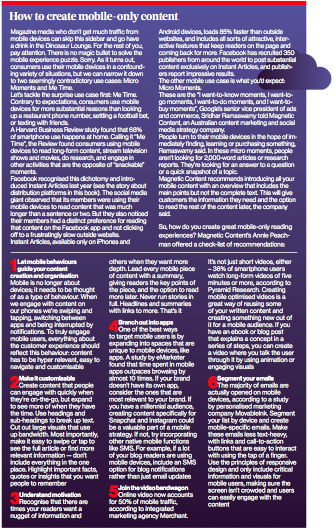
How big is this mobile-only moment?
Before getting into how to create uniquely mo- bile content, let’s make sure everyone grasps the speed and size of the technological and cultural change bearing down on us (most people would say it’s been here for a while and magazine media are already behind). Consumer time spent with digital media on mobile has grown 90% in the last two years, according to comScore. It’s not that consumers are not using their desktops — after all, many people spend eight hours a day working at a desk with a desktop computer — it’s that the desktop growth rate (16%) is a fraction of the mobile growth rate. In terms of hours spent on mobile, the numbers are even more impressive.
In 2014, US adults spent nearly three hours a day on their mobile devices, up from 2 hours, 19 minutes in 2013, according to eMarketer. Desktop hours, which matched mobile hours just a year ear- lier, dropped to 2 hours, 12 minutes in 2014. When it comes to mobile-only users, the trend is also clear. For the first time ever, in March 2015, the number of mobile-only adult internet users in the US exceeded the number of desktop-only internet users, according to comScore. As recently as 2014, the number of desktop-only users (19%) was almost twice that of mobile-only users (10.8%). Today, the number of desktop-only users has fallen by almost half (to 10.6%) while the number of mobile-only users continues to rise (11.3%).
Millennials are giving up their laptops
Looking to the future, comScore found that 21% of US millennials have stopped using desktop computers to go online, relying exclusively on their mobile devices. When it comes to the purchase process, half of US consumers consider mobile to be the most important resource in making purchase decisions, according to a Nielsen survey. More than a third of US consumers told Nielsen that they use mobile exclusively in their purchase decisions.
Heard enough?
Suffice to say the future is clear: It’s going to be a mobile world, if not today, certainly tomorrow.
So, what is magazine media doing to get ready for it?
If a recent study is any indication, not much. “We found that despite the necessity of creating mobile-only journeys for their connected customers, mobile is still grossly underfunded in most organisations,” wrote study co-author and former Altimeter senior researcher Jaimy Szymanski on DigitalEyeMedia.
“This leaves companies unprepared to meet a mobile-as-first-screen reality and perpetuates mobile’s relegation to just another channel, a technology platform, or a portable version of the web. In turn, customers have no choice but to leave, in search of a better experience.”
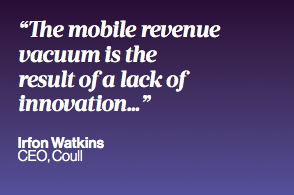
Few publishers actually have a mobile strategy
The 2015 Altimeter study, The Inevitability of a Mobile-Only Customer Experience, also found that a clear and unified mobile strategy remains largely elusive to many executives.
“In order for their companies to survive and maintain relevancy, strategists and executives alike must rethink the role of mobile, particularly where and how it can become the primary channel of engagement for a connected consumer,” according to the report.
The prescription for the future (as in tomorrow): Create a stand-alone, seamless, mobile experience. Go beyond mobile-optimised web- sites, landing pages, content for the smaller screen, or basic branded apps.
“Customer expectations have changed. They used to be more understanding if certain features weren’t part of your mobile app, but now they expect to do whatever they want, whenever and wherever they want to do it,” according to Andres Wolberg-Stok, global head, emerging platforms and services, Citi, who was quoted in the Altimeter report. “The idea of mobile-only design is a game-changer, and we believe it is becoming the new standard,” wrote Szymanski.
And if the mass migration of consumers to mobile wasn’t enough of an incentive to develop a mobile-only strategy, then the belated but now rapid reaction of advertisers to mobile growth should get your attention.
Finally, mobile advertising is starting to follow eyeballs While desktop revenue will still represent the lion’s share of digital income for a while, the growth is in mobile advertising. In 2013, US$32.44 billion was spent on desktop advertising, more than triple the US $10.67 billion spent on mobile advertising that year, accord- ing to a recent eMarketer survey. Just two years later in 2015, mobile advertising nearly tripled to US $28.72 billion while desktop declined to US $29.89 billion.
By 2019, eMarketer projects an almost complete turning of the tables: Mobile US ad dollars will be almost three times desktop spending, with US $65.87bn in mobile marketing to just US $25.35bn in desktop. Globally, advertising budgets for mobile have also gone through the roof. “eMarketer has estimated it to reach US$158.55 billion by 2018,” wrote Shirley Pattison, marketing di- rector at Israeli ad agency firm Imonomy. “At that point, spending on mobile will be more than 50% of all worldwide digital advertising.”
That growing pot of mobile ad cash is not exactly spread evenly across internet firms. In 2015, Facebook and Google alone took in half of the US$28 billion spent on mobile advertising in the US, according to eMarketer. Then it was a steep drop to Twitter in third place at 4.6%, and fourth-place Yahoo at 4.1%. To get a piece of this massive pie, publishers must change their approach. To date, too many continue to force desktop banner ads on small mobile screens.
“If mobile ads are counterproductive to mobile audiences, ruining the user experience, we will alienate people and go out of business,” Schibsted Publishing head of mobile Staffan Engström told WAN-IFRA.
“The mobile revenue vacuum [for publishers] is the result of a lack of innovation… the formats are unexciting ports [recycling] of desktop mainstays,” according to Irfon Watkins, CEO of UK-based video advertising technology company Coull writing on MediaPost. “The display banner, a format that’s been derided as ineffective and of negligible worth on desktop for the last five years, accounts for more than half of mobile ad spend,” said Watkins.
“This isn’t due to some miraculous increase in its effectiveness: it’s due to a real lack of alternatives. “The lack of contextual targeting on mobile is criminal — advertising that isn’t contextually aligned to what [readers are] consuming is incredibly jarring,” he said.
“We must ensure that a lack of innovation doesn’t kill the dream. We need to do away with attempting to port[recycle] formats, while in turn making mobile ads more relevant and easier to track cross device.”
Back at Imonomy, Pattison recommends the Internet Advertising Bureau (IAB) mobile ad formats: “As more online publishers are broadening the types of ads they offer on mobile it has worked extremely well for bringing in new revenue. It goes without Mo saying that the more mobile friendly and responsive publishers make their sites, the better their ads perform.” Here are Pattison’s descriptions of each of the five IAB ad formats:
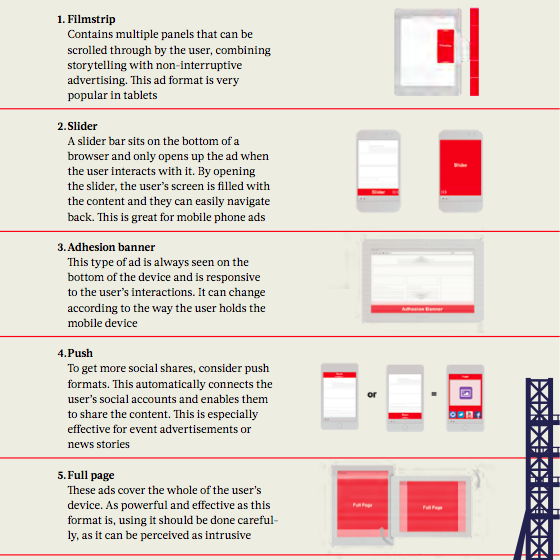
In 2015, the IAB and C3Research released a study showing that the Display Rising Stars ads, introduced by the IAB in 2011 as rich media canvasses for ad creative, are more effective in brand building than the old banner ads. The Rising Star formats delivered 30% stronger brand lift with just one full exposure, rising to 42% when consumers actually interacted with a Rising Stars ad. Rising Stars also beat traditional display ads when it came to ad recall, with consumers remembering half of the Rising Stars viewed — triple the recall rate of the legacy digital display ads.
The IAB study also found:
- Rising Stars ads attracted gaze at a 63% higher rate than traditional IAB ads, and had five times longer total gaze duration
- Consumers were less likely to avoid looking at such ads compared to legacy ads
- Engagement with the Rising Stars ads was significantly higher across the board with respondents saying these ads were more entertaining, creative, humorous, and evoked higher emotional response
- Despite their bigger size, Rising Stars were considered less annoying than traditional ads

So how do you begin creating mobile-only content?
In these days of big data, media strategy no longer need be guesswork backed up by gut feelings. Customer data will tell you why your readers come to your site, what they are looking for, what they do with your content, how much they read, if they find it compelling enough to share, and more. Publishers and editors should not design a mobile strategy based on what they THINK readers want, but on what readers are actually looking for based on their online behaviour.
Examine reader behaviour to guide mobile strategy “Begin by examining the existing custom- er journey,” wrote former Altimeter senior researcher Szymanski. “From there, move on to architecting the desired mobile experience, continually measuring and optimising it for success along the way. Finally, internal alignment is achieved once strategists have validated their mobile-first strategies by proving results.”
As intuitive as this sounds in the 21st century, the study authors found collecting and studying the data is not the norm: “Many organisations skip this critical first step to understand mobile customers’ motivations, engagement patterns, and expectations: A mere 25% of companies have completely mapped the customer journey to better understand under-performing digital touch points.
“Empathising with customers by under- standing the role mobile plays at the core of their lives, in the context of each moment and state of mind, sparks innovation, not iteration,” the report concluded.
Appoint and empower a mobile-only champion
Once you make a commitment to create mo- bile-only content, protect that commitment from slippage by appointing a mobile-only champion whose sole reason for existence will be to make sure your mobile presence delivers the experience mobile readers are looking to have.
The Altimeter report found very few champions. “Right now, mobile tends to exist without an owner to take accountability in the customer experience. As a result, mobile strategies for the most part are focused on an isolated aspect of customer engagement, whether it’s marketing, commerce, loyalty, etc., and very specific instances within each. This is because all of these solitary pro- grammes are owned by different stakeholder groups that are strewn across the organisation and not necessarily in tune or in alignment with one another. It’s not uncommon for these departments to not collaborate with one another, and thus, the mobile experience is discombobulated by design and impossible to deliver an integrated customer journey.” (See our sidebar for ideas on exactly how to create mobile-only content.)
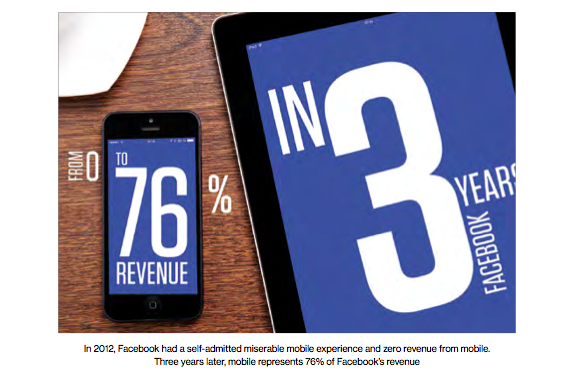
How Facebook took mobile revenue from zero to 76% in two years
In 2012, Facebook, for example, had a self-admitted miserable mobile experience. Three years later, mobile represents 76% of Face- book’s revenue. What happened? (Go to You- Tube to watch Mark Zuckerberg admit to his abject mobile failure followed by stunning mobile ad success: “Mark Zuckerberg on Mo- bile | Disrupt SF 2013”.)
Facebook didn’t just make its website mobile-friendly. Facebook created completely unique mobile experiences geared to what they discovered were the most popular user-need cases. And then they built a unique mobile advertising platform to mimic the way their content took advantage of mobile’s unique properties.
Facebook continues to experiment with decoupling the desktop and mobile experiences, creating new Facebook features as apps to improve the mobile customer experience, largely independent of the Facebook desktop experience.
A word of caution: The Altimeter study found that strategists often equate “mobile” with “smartphone”, developing a one-size-fits-all solution that ignores the substantial differences in device capabilities and user expectations of mobile phones, tablets, and wearables.
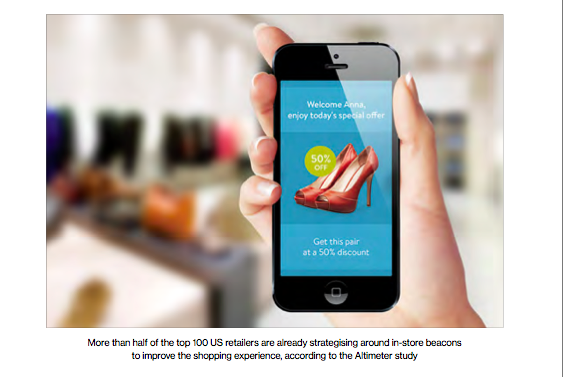
Don’t look now, but low-energy signals are next
And if you’re worried about being behind to- day, don’t look now but new low-energy signals, such as Apple’s iBeacon and Samsung’s Proximity, can deliver in-store mobile connections that could radically change the consumer shopping experience (and your role in making that experience better than ever).
Your own advertisers may already be ahead of you. More than half of the top 100 US retailers are already strategising around in-store beacons to improve the shopping experience, according to the Altimeter study.
So, you have a choice.
Sit back and see where this whole mobile thing goes, leaving the experimenting to others (many of whom will be your competitors). Or anoint your most mobile-savvy staffer as the champion of a mo- bile-only strategy and cut him or her loose to experiment and measure and analyse and pivot and start the process all over again. (The goal of that mobile champion should be to work him, or herself, out of a job, gradually training staff in both editorial and advertising to make mobile-only thinking and acting part of their daily responsibilities!)
If you create a mobile experience that meets and exceeds your readers’ mobile needs and expectations, you will also have positive impact on your bottom line. And you will beat your competitors to the punch.
For a change.

This article is one of many chapters published in our book, Innovations in Magazine Media 2016 World Report.


